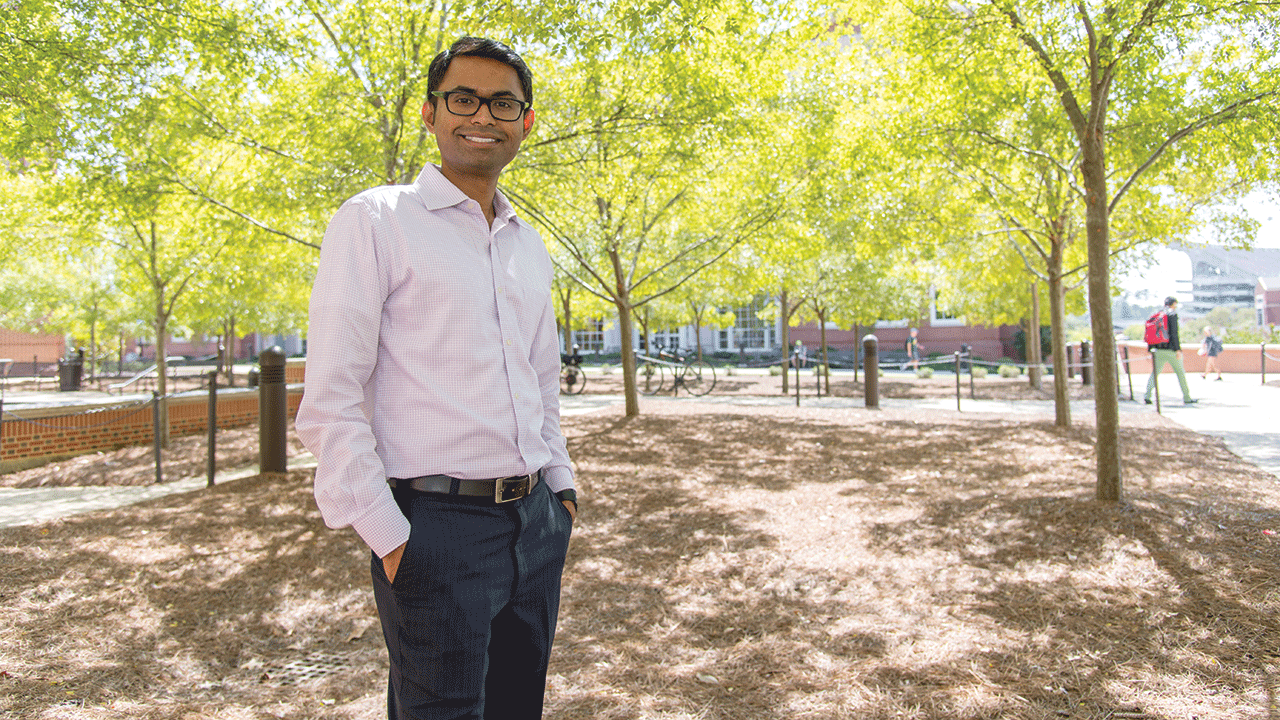Aerospace engineering faculty member uses bio-inspired surface textures to ensure smooth flight
Published: Jul 27, 2023 12:40 PM
By Joe McAdory
Vrishank Raghav, assistant professor of aerospace engineering, is part of a three-year, $600,000 Defense Established Program to Stimulate Competitive Research (DEPSCoR) grant to better understand how bio-inspired surface texturing of aircraft wings can ensure smooth flight.
With summer travel in full swing, there have been increased reports of ‘severe turbulence’ during flights across the US. Furthermore, significant delays in flights due to adverse weather conditions are also very common. “That’s because weather patterns bring in harsh aerodynamic environments for airplanes to fly through,” said Raghav. “These could be updrafts, downdrafts, or vortices that are essentially swirling packets of air that interact with an aerodynamic surface like a wing. When this interaction happens, it can lead to unsteady perturbations on the wing, which results in vibrations and potentially a stalling condition which is very dangerous.”
Is there an optimal solution to mitigate the problem? Raghav is assisting principal investigator Gokul Pathikonda, assistant professor of mechanical and aerospace engineering at Arizona State University, to identify a solution. Their study, “Understanding Vortex Turbulent Boundary Layer Interactions to Mitigate Separation Using Textured Surfaces,” is supported by the Air Force Office of Scientific Research and is part of an $18 million collaboration among 28 teams nationwide.
While Pathikonda will explore bio-inspired surface textures that interact with the turbulent air flow close to the surface, Raghav, director of Auburn University’s Applied Fluids Research Group, will engineer Pathikonda’s findings onto a scaled-down wing and test them in a wind tunnel.
“Gokul will deliver his findings on how bio-inspired surface textures modify the flow, then we will conduct aerodynamic experiments here,” Raghav said. “It will be a back-and-forth process until we arrive at an optimized solution. Gokul will specifically look at micro-texturing of the surfaces and what happens to the boundary layer of the flow – very close to the surface. When one makes such surface modifications, it affects the behavior of the boundary layer and in turn could have a significant influence on the overall aerodynamics of the wing. We are going to take the knowledge that he develops, and apply it to a scaled-down wing and assess the aerodynamic benefits of bio-inspired textured surfaces”
Raghav, who earned a National Science Foundation CAREER Award in 2022, suggested that surface texturing is commonly observed in nature on wings of aerial flyers such as birds or marine swimmers such as sharks. It is believed that these surface textures provide aerodynamic or hydrodynamic benefits that we do not yet completely understand.
“Look very closely at bird wings,” he said. “They are optimized over millions of years of evolution for flight to perhaps reduce drag. Birds have what is known as a herringbone texturing on the wing feathers. These converging-diverging sections help control the flow and make it smoother. We're going to take that surface texturing inspiration from these biological flight animals and apply it to wings to test if they will help improve performance during adverse aerodynamic conditions.”
There’s more to this study than wings or textured surfaces, however. This DoD proposal requires two collaborators to work together, but any collaborator who has received previous DoD funding was not eligible for the funding. There’s a caveat – one could act as a mentor.
Raghav earned a DoD grant in 2019 for his study on novel time-resolved rotating frame measurements for rotating flows …. Until now, Pathikonda, who started his faculty position in 2020, had not. However, Raghav and Pathikonda knew each other at the National Institute of Technology in Warangal, India, where Raghav mentored Pathikonda. They went their own ways to graduate school and later reconnected at Georgia Tech, where Raghav mentored Pathikonda through the faculty application process. Now, he’s mentoring him again through this grant with the Department of Defense.
“I was very grateful to have the opportunity to help a colleague through that process, and especially someone who I knew from before. It provided me an opportunity to share what I have learned over the past few years and I am happy that it helped Gokul win the grant.”
Media Contact: , jem0040@auburn.edu, 334.844.3447
Vrishank Raghav is director of Auburn University's Applied Fluids Research Group.


